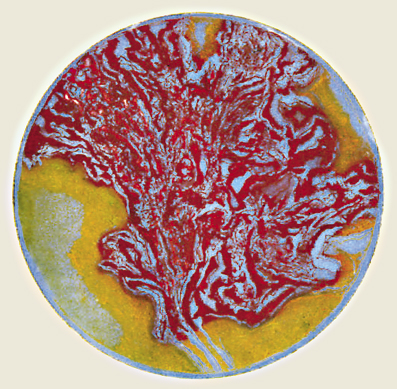Anju Chaudhuri
Atelier 8ATELIER-8
133 Rue de Bagnolet
Paris, 75005 France
Email: chaudhuri@caramail.com
Technical Demonstration : “The Magic of Viscosity: Viscosity of Oil in Color Etching”
For this demonstration I will present methods of printing a viscosity etching. Etching is drawing a form/shape with special tools like points, needles, brushes, with different acid resistant varnishes on metal plates. The resist is exposed to the corrosive action of an acid. Once the plate is sufficiently etched in the right areas, colour is applied by hand (intaglio). After wiping the plate, other colours can be applied with different rollers. The discovery of the oil’s viscosity by Atelier 17 makes it possible to print different colors on the same plate, at the same time. The viscosity of the color depends on the quantity of oil added to the color. The colors are automatically separated by their difference in viscosity, which keeps them from mixing in with each other. On the contrary, if you use equal quantities of oil in different colours, the colors will mix. The direction and the force with which the colour is applied to the plate, by the roller, makes a difference. The level and direction of the plate play a role. It is important to construct the plate in such a way that the surface is of various levels and textures. This can be achieved by grounds, aquatints, scraping, polishing, cross-hatching lines. Hard or soft rollers are used to reach different depths of the plate. The direction of the roller, vertical or horizontal has to be decided. Taking the process further, Chine collé can be applied at printing stage by adding a lightweight colour paper (Japanese, Chinese). This is placed on the plate with special glues before printing. This way, not only is an additional colour present in the print, but all the details of the etching, comes through the transparent paper with a magical effect.
 ANJU CHAUDHURI was born in Calcutta and later attended the Government College of Art, Calcutta and through a national scholarship progressed to the west coast, to attend the University of Baroda. A Commonwealth Scholarship enabled her to study later at St. Martins School of Art, London. She then went to Ecole de Beaux Arts and Atelier 17, Paris through a French Government Scholarship. Living between two cultures, experiencing magic moments, enriched her personality and work; while her childhood was nurtured by Hindu mythology. As a young adult she spent the ‘swinging sixties’ in London, May 1968 in Paris and the seventies in Amsterdam. Anju has participated in solo and collaborative exhibitions worldwide, including India, Europe, America, North Africa and Australia. Her prints have been selected for numerous biennials and triennials in Cadaques in Spain; Ljubliana in Slovenia: the International Biennale in Auvergne and the Triennale de Chamellier in France; Triennale de Bharat in India; the International Contemporary Prints Kuala Lumpur in Malaysia; the Berlin Intergraphic 90 in Germany; and the Cracow Biennale in Poland, among others. Her work has been exhibited at the Birla Academy and the Lalit Kala Academy in India; the Strasbourg Fair and the Centre Pompidou Center in France; the Ubersee Museum in Germany; the Stedlijk Museum and the Gemente Museum in Holland; and Galleria Harmonica in Finland. Her art works are in the collections of the National Gallery of Modern Art (New Delhi, India); National Library and the Ministry of Cultural Affairs (Paris, France); the Bronx Museum (New York, USA); and the Victoria and Albert Museum (London. UK). Her workshops have been held in France, India, Finland and Australia. Choosing to live in Paris with her daughter, commuting yearly to India, she bridges the cultural barriers between the East and the West.
ANJU CHAUDHURI was born in Calcutta and later attended the Government College of Art, Calcutta and through a national scholarship progressed to the west coast, to attend the University of Baroda. A Commonwealth Scholarship enabled her to study later at St. Martins School of Art, London. She then went to Ecole de Beaux Arts and Atelier 17, Paris through a French Government Scholarship. Living between two cultures, experiencing magic moments, enriched her personality and work; while her childhood was nurtured by Hindu mythology. As a young adult she spent the ‘swinging sixties’ in London, May 1968 in Paris and the seventies in Amsterdam. Anju has participated in solo and collaborative exhibitions worldwide, including India, Europe, America, North Africa and Australia. Her prints have been selected for numerous biennials and triennials in Cadaques in Spain; Ljubliana in Slovenia: the International Biennale in Auvergne and the Triennale de Chamellier in France; Triennale de Bharat in India; the International Contemporary Prints Kuala Lumpur in Malaysia; the Berlin Intergraphic 90 in Germany; and the Cracow Biennale in Poland, among others. Her work has been exhibited at the Birla Academy and the Lalit Kala Academy in India; the Strasbourg Fair and the Centre Pompidou Center in France; the Ubersee Museum in Germany; the Stedlijk Museum and the Gemente Museum in Holland; and Galleria Harmonica in Finland. Her art works are in the collections of the National Gallery of Modern Art (New Delhi, India); National Library and the Ministry of Cultural Affairs (Paris, France); the Bronx Museum (New York, USA); and the Victoria and Albert Museum (London. UK). Her workshops have been held in France, India, Finland and Australia. Choosing to live in Paris with her daughter, commuting yearly to India, she bridges the cultural barriers between the East and the West.


